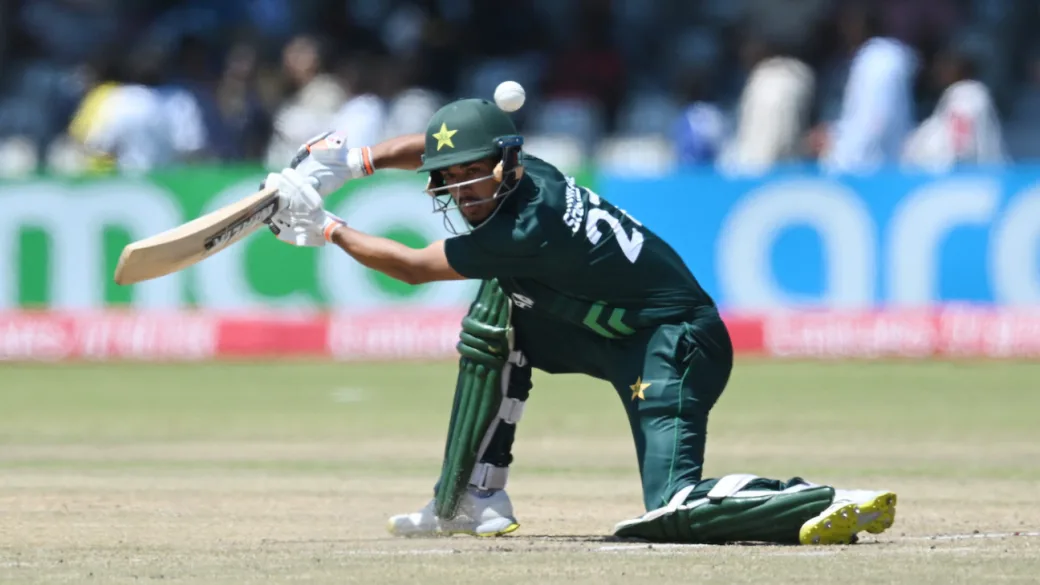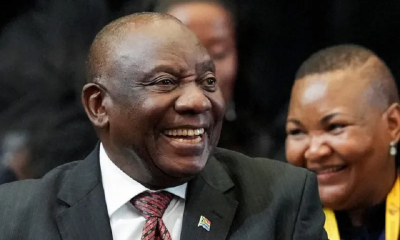Latest News
Pakistan, Zimbabwe and South Africa script crushing wins

Shahzaib Khan continued his stunning run of form, slamming an unbeaten 80 to take Pakistan past New Zealand by ten wickets in their men’s Under-19 World Cup match in East London, but the canter was really set up by the bowling unit.
New Zealand, after electing to bat first, were 28 for 3 in seven overs, Luke Watson, Tom Jones and Snehith Reddy all falling to Ubaid Shah’s pace. There was a bit of a fightback, first courtesy Oliver Tewatiya (29) and captain Oscar Jackson (12), and then a more substantial one from Tewatiya and top-scorer Lachlan Stackpole (41), adding 61 runs for the fifth wicket. But New Zealand, who had recovered from their wobbly start to reach the halfway mark at a relatively respectable 116 for 4, collapsed again.
Stackpole and Tewatiya were both dismissed by offspiner Naveed Ahmed Khan between the 26th and 28th overs, and this time, there were no fight-backs. New Zealand folded for 140, with left-arm spinner Arafat Minhas returning spectacular figures of 3 for 6 from five overs.
Pakistan were unlikely to be tested too much by that target, and with Player of the Match Shahzaib hitting 80 in 86 balls, with ten fours and three sixes, and Shamyl Hussain scoring 54 in 66 with six fours and two sixes, they rushed to the target in just 25.2 overs. That made it three in three for Pakistan, taking them top of the Group D table, with New Zealand in second place. Yesterday, Nepal became the third team to qualify for the Super Six stage from the group after a thrilling win over Afghanistan.
Brief scores:
Pakistan Under 19s 144 for 0 in 25.2 overs (Shahzaib Khan 80*, Shamyl Hussain 54*) beat New Zealand Under 19s 140 in 38 overs (Lachlan Stackpole 42, Oliver Tewatiya 29; Arafat Minhas 3-06, Ubaid Shah 3-30, Naveed Ahmed Khan 2-26) by ten wickets
It wasn’t the most entertaining contest, but after 85.3 overs in which 293 runs were scored and only ten wickets claimed, Group C had its third Super Six qualifier – Zimbabwe.
Namibia, who had earlier lost to Australia and Sri Lanka, the top-two sides in the group, but had at times looked a stronger side than Zimbabwe, came undone when it mattered the most. Their batters just couldn’t get going against the likes of Ryan Simbi (3-20), Newman Nyamhuri (4-21), Kohl Eksteen (1-18) and Mathew Schonken (0-26), who combined for returns of 8 for 85 from 38 overs.
The result was 146 for 8 from 50 overs. It could have been worse, but Hanro Badenhorst and Woutie Niehaus combined for 46 unbeaten runs for their ninth-wicket stand – in 13.1 overs! – to give Namibia a bit more than they might have expected at 100 for 8 in the 37th over.
The chase was straightforward. Ryan Kamwemba fell with the total at 21 in the fifth over, but fellow opener Panashe Taruvinga batted through the chase to finish with 59 from 115 balls, and Brandon Sunguro (29) and Campbell Macmillan (10*) gave him the support he needed to complete the job in 35.3 overs.
Brief scores:
Zimbabwe Under 19s 147 for 2 in 35.3 overs (Panashe Taruvinga 59*, Brandon Sunguro 29; Jack Brassell 1-24) beat Namibia Under 19s 146 for 8 in 50 overs (Hanro Badenhorst 39*, Gerhard Janse van Rensburg 23, Alexander Busing-Volschenk 22; Newman Nyamhuri 4-21, Ryan Simbi 3-20) by eight wickets
 Steve Stolk smashed Scotland into submission (Cricinfo)
Steve Stolk smashed Scotland into submission (Cricinfo)Steve Stolk and Dewan Marais smashed a combined 15 fours and 11 sixes to help South Africa pummel Scotland in Potchefstroom.
Jamie Dunk and Owen Gould’s 90s had taken Scotland to a competitive 269 for 9, but Stolk’s blitz ensured their campaign wouldn’t enter the Super Six stage.
Stolk was in the mood for boundaries from the start. He kicked off the chase with three fours off Qasim Khan, and followed it up with a 34-run over, with five sixes and a four, also off Qasim to reach his half-century in a remarkable 13 balls. South Africa’s fifty came up in just 18 balls.
Gould, who brought himself on in place of Qasim, was caught in Stolk’s whirlwind as South Africa reached their hundred in 7.1 overs. Nikhil Koteeswaran slowed things down a bit by removing both openers – Stolk and Lhuan-dre Pretorius – in the space of 11 balls. Just a temporary slowdown.
Marais started sedately start along with Tristan Luus, but then launched a flurry of boundaries as South Africa passed 200 in 20 overs, the target within sight. He belted two fours and a six off Koteeswaran, four fours off Adi Hegde, and three off Logan Briggs as the final three over of the 27-over chase went for 55 runs.
South Africa had put Scotland in to bat earlier in the day, and Dunk oversaw a slow but solid start. Riley Norton got Hegde right after a 27-run opening powerplay, but Dunk found support in a 57-run stand with Alec Price followed by a 115-run stand with Gould as Scotland reached 200 at a run rate of 4.76.
Dunk fell to Norton but Gould’s presence coupled with a cameo from Uzair Ahmad (23 in eight balls) brought 69 runs in the last eight overs. Kwena Maphaka removed Gould in the final over before three run outs closed the innings.
Brief scores:
South Africa Under 19s 273 for 3 in 27 overs (Steve Stolk 86, Dewan Marais 80*, Luhan-dre Pretorius 22, David Teeger 43*; Nikhil Koteeswaran 2-52) beat Scotland Under 19s 269 for 9 in 50 overs (Owen Gould 97, Jamie Dunk 90, Uzair Ahmad 23; Riley Norton 3-48, Kwena Maphaka 2-53) by seven wickets
(Cricinfo)
Business
Trump heads to Saudi Arabia eyeing more investment in US

With US President Donald Trump due to visit Gulf states this week, a key focus will be securing significant new investment for the US economy.
“President Trump wants the announcement [of more Gulf money for the US],” says economist Karen Young, a senior fellow at the Middle East Institute think tank.
“He wants to have a big poster in a meeting that describes where these investments might go. And some estimation of what they will do to the American economy in terms of job creation or his big push, of course, on domestic manufacturing.”
Trump is due to arrive in the Saudi capital, Riyadh, on Tuesday 13 May, to meet the country’s de facto leader Crown Prince Mohammed bin Salman.
Trump is then expected to attend a summit of Gulf leaders in the city on 14 May, before travelling to Qatar that same day, and then ending his three-day trip in the United Arab Emirates (UAE) on 15 May.
The economic importance of the region to Trump is highlighted by the fact that the visit to Saudi Arabia was due to be the first overseas trip of his second term in the White House. That was before the death of Pope Francis necessitated Trump attending his funeral in Rome towards the end of April.
Saudi Arabia was also the first country that Trump visited during his first term of office, going against the modern practise of US presidents to start with the UK, Canada or Mexico.

Securing new investments in the US from Gulf states, and particularly from their state-backed sovereign wealth funds, will help Trump to signal back home that his “America First” agenda is delivering results.
The presidential visit is drawing top Wall Street and Silicon Valley leaders to Saudi Arabia. A Saudi-US investment forum on 13 May in Riyadh will feature CEOs from BlackRock, Palantir, Citigroup, IBM, Qualcomm, Alphabet, and Franklin Templeton.
The push comes amid economic headwinds, as President Trump’s new import tariffs have significantly disrupted global trade, confidence, and the US economy itself. US economic output fell in the first three months of this year, its first fall in three years.
Back in January, Prince Mohammed said that Saudi Arabia would invest $600bn (£450bn) in the US over the next years. However, Trump has already said that he’d like that to rise to $ 1tn, including purchases of more US military equipment.
According to Ali Shihabi – a Saudi commentator and author, with close ties to the Saudi government – a number of economic agreements will be signed during the trip.
“These deals will further integrate the Saudi and US economies together, joint ventures in the kingdom, in the United States, procurements of American weapons and goods,” says Mr Shihabi.
Saudi Arabia’s sovereign wealth fund, the Public Investment fund (PIF), which controls assets worth $925bn, already has numerous investments in the US. These include Uber, gaming firm Electronic Arts, and electric car firm Lucid.
Meanwhile, the UAE has already committed to investing $1.4tn in the US over the next 10 years, in sectors such as AI, semiconductors, energy and manufacturing. This was announced by the White House in March after the UAE’s national security advisor, Sheikh Tahnoon bin Zayed Al Nahyan, met President Trump in Washington.
Yet Ms Young from the Middle East Institute says that the scale of these investments is not realistic in the short term. She instead says that they are long-term strategic moves, and that the figures should be taken “with a little bit of a grain of salt”.
Regarding specific deals that could be announced during Trump’s visit, it is widely reported that Saudi Arabia will agree to buy more than $100bn of US arms and other military items.
These are said to include missiles, radar systems and transport aircraft.
The US has been a longstanding arms supplier to Saudi Arabia, but in 2021 the then Biden administration stopped selling Riyadh offensive weapons, citing concerns about the country’s role in the war in neighbouring Yemen.
The 2018 killing of Saudi journalist Jamal Khashoggi was also widely reported to be a factor. A US report said that Prince Mohammed had approved the murder.
The Biden White House resumed the sale of these weapons last year. While it cited that the Saudis had stopped bombing Yemen, some commentators said that the US was seeking Saudi assistance to help end the conflict in Gaza and aid its future reconstruction.

Mr Shihabi says Saudi Arabia will be seeking assurances from the White House that the US will implement a “more efficient procurement system”, enabling the Gulf state to access ammunition and military equipment far more quickly and easily.
“The Trump administration is initiating procedures to facilitate those deals. So, it’s expected that this process will improve immediately,” he adds.
Artificial intelligence is the other topic that will dominate the agenda during Mr Trump’s visit. Talks are expected to centre on attracting greater Gulf investment into US tech firms, and boosting the region’s access to cutting-edge American semiconductors.
The UAE and Saudi Arabia have been investing billions of dollars into tech and AI sectors as try to diversify their economies away from oil.
The Emiratis, in particular, are keen to establish themselves as a global AI hub.
Last week, the Trump administration scrapped the Biden-era chip regulations that placed restrictions on exports of advanced US chips to more than 120 countries including the Gulf states.
The White House is expected to draft new rules that would potentially involve direct negotiations with countries like the UAE.
“For the UAE, this is absolutely essential,” says Ms Young. “They are aggressively building out their AI capacity. So, for them getting access to US technology is imperative to be the best.”
While much attention will be on Trump courting Gulf capital for the US, Saudi Arabia is equally focused on drawing American investment into its ambitious Vision 2030 program.
Led by giant construction projects, such as the building of a linear city called The Line, Vision 2030 is central to the Saudi government’s continuing efforts to diversify the country’s economy away from oil.
It also involves pouring resources into entertainment, tourism, mining and sports.
However, foreign direct investment into Saudi Arabia declined for a third straight year in 2024, reflecting persistent challenges in attracting overseas capital.
The fall in global oil prices since the start of the year has further strained Riyadh’s finances, increasing pressure to either raise debt or cut spending to sustain its development goals.
Oil prices tumbled to a four-year low amid growing concerns that a trade war could dampen global economic growth.
The decline was further fuelled by the group of oil producing nations, Opec+, announcing plans to increase output.
Saudi Arabia is part of that group, and some commentators said that the rise was in part a desire to please Trump who has called for lower oil prices.
Other analysts said the reason was more that Opec+ remains confident that the global economy is growing.
The US-Saudi Business Council, is an organisation that aims to boost trade ties between the two countries.
It is hoping that Trump’s visit will push American businesses to explore more opportunities in Saudi Arabia, especially in sectors like AI, healthcare and education.
“The Saudi government is looking heavily to invest in these sectors. There is a very big appetite for Saudi companies to collaborate with American companies,” Hutham Al Jalal, who heads the Riyadh office for the organisation, tells the BBC.
Saudi officials are said to be confident that some deals in these sectors will be secured during Trump’s visit.
For Saudi Arabia, Trump’s visit is about strengthening ties with their longest-standing Western ally – a relationship that grew strained during the Biden years. For President Trump, it is about landing investment deals that can be framed as a win for his economic agenda.
“President Trump is looking for a headline of big investments in America, and he will get that from this trip,” adds Mr Shihabi.
[BBC]
Latest News
Pope Leo urges release of imprisoned journalists in first news conference

Pope Leo XIV demands the release of imprisoned journalists in the first news conference of his pontificate
Addressing the world’s media in Vatican City, he says he reiterates the Church’s solidarity with them for “seeking the truth” He also calls for “the precious gift of free speech” to be safeguarded, and adds: “Let us disarm words…so we can disarm the world”
[BBC]
Latest News
US and China agree to slash tariffs for 90 days

The US and China have agreed a deal that will significantly cut the import tariffs, or taxes, both sides have imposed on one another for a 90-day period.
US Treasury Secretary Scott Bessent said both countries would lower their reciprocal tariffs by 115% for 90 days.
The announcement came after the two countries held talks in Switzerland, the first between the two countries since US President Donald Trump had levied steep tariffs on Chinese imports.
The huge tariffs caused turmoil in the financial markets and sparked fears of a global recession.
President Trump had imposed a 145% tariff on Chinese imports, while Beijing responded with a 125% levy on some US goods.
However, the US tariffs on Chinese imports will now be cut to 30% for 90 days, while Chinese tariffs on US imports will be cut to 10% for the same period of time. The pause will begin on 14 May.
The US measures still include an extra component aimed at putting pressure on Beijing to do more to curb the illegal trade in fentanyl, a powerful opioid drug.
The imposition of the tariffs had raised the prospect of trade between the two countries slumping, with US ports reporting a sharp drop in the number of ships scheduled to arrive from China.
Meanwhile Beijing has become increasingly concerned about the impact the tariffs could have on its economy. Factory output has already slowed and there are reports some firms were having to lay off workers as production lines of goods bound for the US began to grind to a halt.
Announcing the agreement, Bessent said: “The consensus from both delegations this weekend is neither side wants a decoupling.
“What had occurred with these very high tariffs was the equivalent of an embargo, and neither side wants that.
“We do want trade, we want more balanced trade, and I think that both sides are committed to achieving that.”
China’s commerce ministry said the agreement reached with the US was an important step to “resolve differences” and “lay the foundation to bridge differences and deepen co-operation”.
News of the agreement boosted stock markets, with Hong Kong’s benchmark Hang Seng Index ending the day up 3%. China’s Shanghai Composite Index had closed before details of the deal came out, and ended 0.8% higher.
European stocks rose in early trade and early indications were that the main US stock markets will open up by 2-3%.
[BBC]
-

 Business7 days ago
Business7 days agoAitken Spence Travels continues its leadership as the only Travelife-Certified DMC in Sri Lanka
-

 Latest News6 days ago
Latest News6 days agoNPP win Maharagama Urban Council
-

 Business7 days ago
Business7 days agoLinearSix and InsureMO® expand partnership
-

 Features2 days ago
Features2 days agoSAITM Graduates Overcome Adversity, Excel Despite Challenges
-

 Business5 days ago
Business5 days agoJohn Keells Properties and MullenLowe unveil “Minutes Away”
-

 Sports2 days ago
Sports2 days agoASBC Asian U22 and Youth Boxing Championships from Monday
-

 News2 days ago
News2 days agoDestined to be pope:Brother says Leo XIV always wanted to be a priest
-

 Foreign News3 days ago
Foreign News3 days agoMexico sues Google over ‘Gulf of America’ name change
























